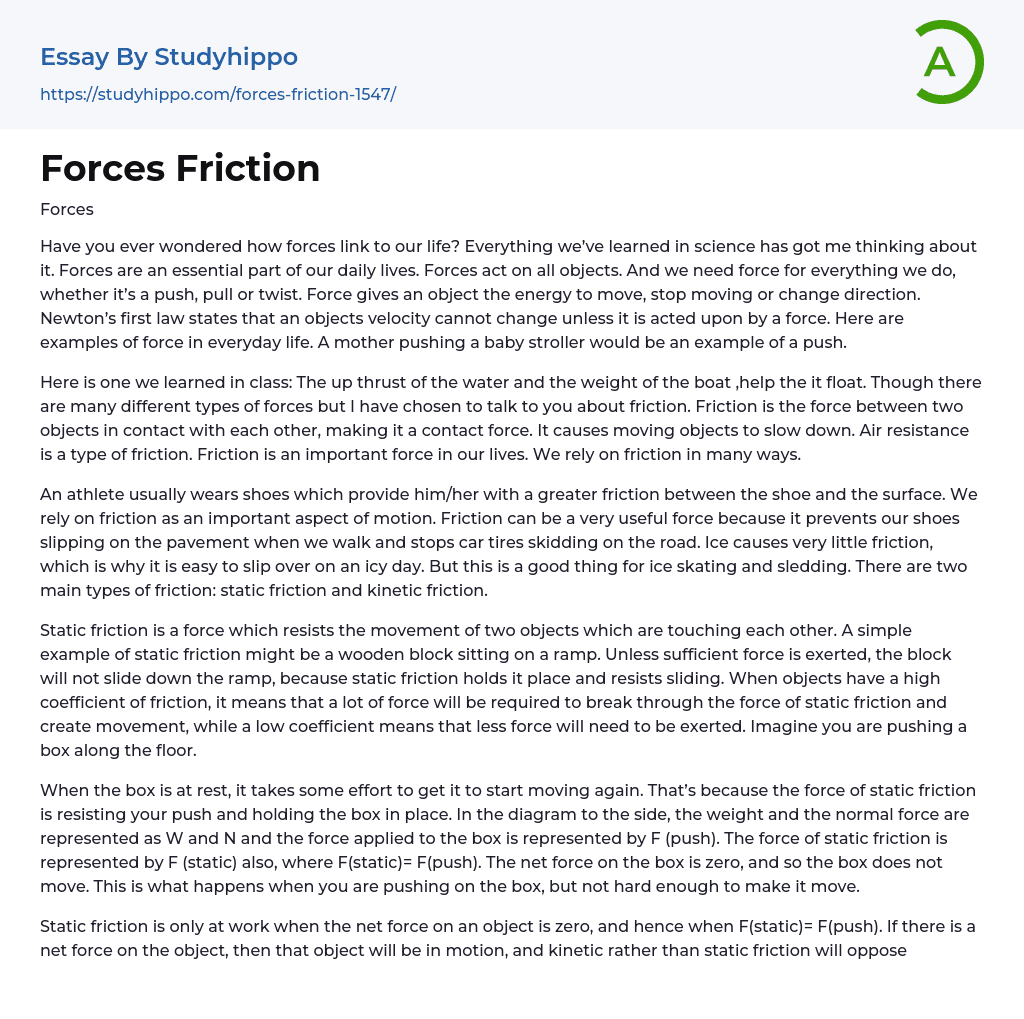Forces
Science helps us understand the connection between forces and how they impact our daily lives. Forces are essential to our everyday existence.
Force is crucial for the movement, stoppage, or change in direction of all objects. These forces can be in the form of pushing, pulling, or twisting. As per Newton's first law, an object will not change its velocity unless there is a force acting on it.
These are examples of force in daily life: a mother pushing a baby stroller as a push, and the up thrust of water and weight of a boat helping it float. Among the various types of forces, I have chosen to discuss friction.
Friction, which is a contact force, occurs when two objects make contact and leads to a decrease in the speed of moving objects. Air resistance is a type of friction that significantly affects our lives
.... We heavily depend on friction in various ways. For instance, athletes commonly wear specialized shoes that offer increased friction between the shoe and the surface.
Friction is essential in motion, serving as a helpful force that prevents slipping on pavement while walking and skidding of car tires on the road. Ice, with minimal friction, enables easy slipping but is perfect for activities like ice skating and sledding. There are two primary forms of friction: static friction and kinetic friction.
Static friction is the resistance to sliding between two objects in contact, unless a sufficient force is exerted. It can be measured using the coefficient of friction, which indicates the amount of force needed to overcome static friction and start movement. A higher coefficient requires more force while a lower coefficient requires less force. Fo
example, when a wooden block is placed on a ramp, static friction provided by either a higher or lower coefficient keeps it from sliding and maintains its position.
When you try to push a box on the floor, you'll observe that it needs some force to start moving again if it's not already in motion. This occurs because static friction counters your push and keeps the box still. In the diagram next to this text, the weight and normal force are labeled as W and N respectively, while the force applied to the box is referred to as F (push). The force of static friction is also denoted as F (static), where F(static) equals F(push).
If the net force on an object is zero, it will stay still because insufficient force has been exerted to make it move. Static friction only happens when the net force equals the applied force, indicating F(static) = F(push). Conversely, if there is a net force, the object will be in motion and kinetic friction will oppose its movement instead of static friction.
Kinetic friction, which is also referred to as sliding or fluid friction, is the force that occurs when objects are in motion. This force can occur between solid objects or between a solid and a gas or liquid. When sufficient force is exerted, the box will initiate movement.
For the box to keep moving, there must be a continuous strong and steady force applied. If the pushing force stops, the box will immediately stop due to the opposing force of kinetic friction. Although kinetic friction always opposes the pushing force, it doesn't have to be equal in magnitude. In the diagram
shown, Fkinetic is smaller than Fpush, causing a net forward force that accelerates the box at velocity V.
If the force applied to push an object is equal to the kinetic force, then there will be no resultant force on the box and it will not move. In conclusion, forces are necessary in our daily lives and without them, it is unclear how our lives would have progressed. Despite being unseen, forces are vital for our survival in the continuous cycle of life.
- Accounting essays
- Marketing essays
- Automation essays
- Business Cycle essays
- Business Model essays
- Business Operations essays
- Business Software essays
- Corporate Social Responsibility essays
- Infrastructure essays
- Logistics essays
- Manufacturing essays
- Multinational Corporation essays
- Richard Branson essays
- Small Business essays
- Cooperative essays
- Family Business essays
- Human Resource Management essays
- Sales essays
- Market essays
- Online Shopping essays
- Selling essays
- Strategy essays
- Management essays
- Franchising essays
- Quality Assurance essays
- Business Intelligence essays
- Corporation essays
- Stock essays
- Shopping Mall essays
- Harvard Business School essays
- Harvard university essays
- Trade Union essays
- Cooperation essays
- News Media essays
- Waste essays
- Andrew Carnegie essays
- Inventory essays
- Customer Relationship Management essays
- Structure essays
- Starting a Business essays
- Accounts Receivable essays
- Auditor's Report essays
- Balance Sheet essays
- Costs essays
- Financial Audit essays
- International Financial Reporting Standards essays
- Tax essays
- Accountability essays
- Cash essays
- Principal essays




